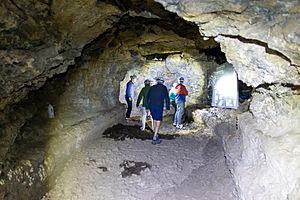Cueva del Viento facts for kids
The Cueva del Viento (which means "Wind Cave") is an amazing natural wonder. It's the biggest lava tube system in Europe. In fact, it's the sixth largest in the whole world! Only some lava tubes in Hawaii are bigger. It's also known as the most complex volcanic cave system globally. This is because it has many different levels and pathways.
This incredible cave was formed by lava flows from a volcano called Pico Viejo. This volcano is right next to the famous Teide mountain. You can find the Cueva del Viento in a town called Icod de los Vinos. This town is on the northern side of Tenerife island in Spain.
The cave stretches for more than 17 kilometres (11 mi) (that's over 10 miles!). It has three main levels of passages. Each level is full of cool geological features. These include things like lava pits and lava terraces.
Contents
Discovering Ancient Life in the Cave
The Cueva del Viento is a treasure chest for fossils. Scientists have found bones of ancient animals here. These animals are part of what's called the "Canarian megafauna". This means very large animals that used to live on the Canary Islands.
Giant Lizards and Rats
Among the discoveries are bones of Gallotia goliath. This was a giant lizard that is now extinct. They also found bones of Canariomys bravoi. This was a huge rat that also no longer exists. Finding these fossils helps us learn about the past life on the islands.
Ancient People and the Cave
Long ago, the Canary Islands were home to the Guanches. These were the native people of the islands. They were an ancient Berber group. Archaeologists have found their remains in several entrances to the cave system. This shows that the Guanches used or explored parts of the Cueva del Viento.
Visiting Cueva del Viento Today
Today, the Cueva del Viento is a very popular place to visit. It's a major tourist attraction on the island of Tenerife. Visitors can take guided tours to explore parts of this amazing underground world. It's a great way to learn about volcanoes and geology.
See also
 In Spanish: Cueva del Viento para niños
In Spanish: Cueva del Viento para niños



